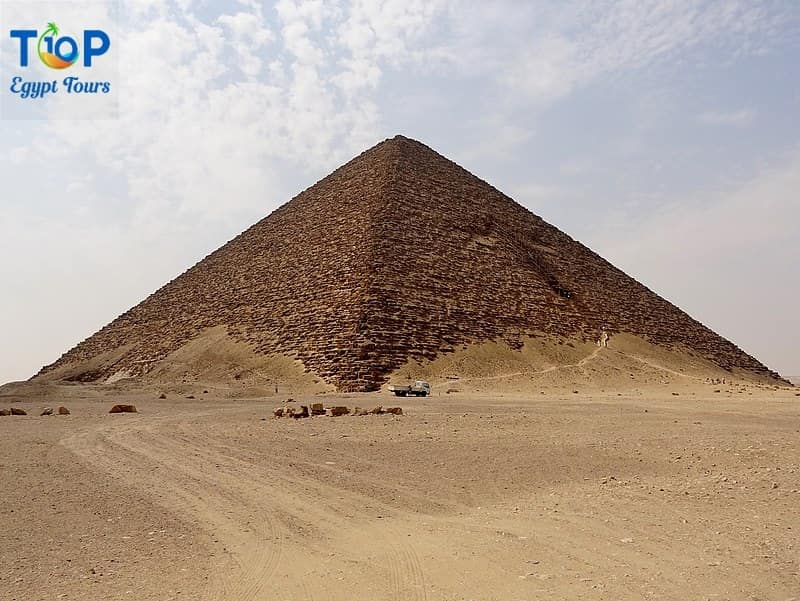The Red Pyramid, located in Dahshur, Egypt, is a magnificent ancient structure that stands as a testament to the architectural prowess of the ancient Egyptians. As the third-largest pyramid in Egypt, it holds significant historical and cultural importance. Exploring the Red Pyramid allows visitors to appreciate its impressive construction, delve into its historical significance, and gain insight into the ancient Egyptian civilization.
In this article, we will uncover for you the Red Pyramid with Top Ten Egypt.
Historical Significance of the Red Pyramid: A Royal Burial Site
The Red Pyramid, also known as the Bent Pyramid due to its unique shape, was built during the Old Kingdom period of ancient Egypt, around 2600 BCE. It was constructed as the burial site for Pharaoh Sneferu, who was the founder of the Fourth Dynasty. The pyramid represents a transition in pyramid construction techniques, as it showcases both the earlier step pyramid style and the later smooth-sided pyramid style. Its historical significance lies in its connection to the royal lineage and the architectural advancements of ancient Egypt.
Architecture of the Red Pyramid: A Marvel of Engineering
The Red Pyramid is a remarkable architectural achievement. It was constructed using large limestone blocks, creating a smooth outer surface that originally had a reddish hue, giving the pyramid its name. The pyramid’s unique bent shape, with a shallower angle at the lower part and a steeper angle at the upper part, sets it apart from other pyramids in Egypt. The interior of the pyramid features a series of corridors and chambers, including the burial chamber where Pharaoh Sneferu was laid to rest. The precision and scale of the construction highlight the advanced engineering skills of the ancient Egyptians.
Unveiling Ancient Egyptian Civilization
It provides valuable insights into the culture, beliefs, and achievements of ancient Egypt. It represents the significance of pyramid complexes as monumental tombs for Pharaohs, showcasing the religious and funerary practices of the time. The pyramid’s construction techniques and architectural innovations offer a glimpse into the ingenuity and craftsmanship of ancient Egyptian builders. By exploring the Red Pyramid, visitors can gain a deeper understanding of the ancient civilization that laid the foundation for Egypt’s rich cultural heritage.
Visiting the Red Pyramid: A Journey into Ancient Egypt
A visit to the Red Pyramid offers a unique opportunity to experience the grandeur of ancient Egypt firsthand. Visitors can explore the pyramid’s exterior, marvel at its towering structure, and appreciate the precision of its construction. Guided tours are available to lead visitors through the pyramid’s interior, allowing them to walk in the footsteps of pharaohs and witness the ancient burial chambers. While climbing to the pyramid’s pinnacle is not permitted, visitors can still appreciate the vastness and significance of this ancient monument.
Conclusion
The Red Pyramid, located in Dahshur, Egypt, is a magnificent ancient structure that stands as a testament to the architectural prowess of the ancient Egyptians. As the third-largest pyramid in Egypt, it holds significant historical and cultural importance. Exploring the Red Pyramid allows visitors to appreciate its impressive construction, delve into its historical significance, and gain insight into the ancient Egyptian civilization.
Conclusion:
It stands as a testament to the architectural achievements and cultural legacy of ancient Egypt. Its historical significance, unique design, and impressive scale make it a captivating destination for those interested in exploring Egypt’s ancient civilization. By arranging a tour to the Red Pyramid, visitors can immerse themselves in the architectural marvels of the past, gain insights into the religious and funerary practices of ancient Egypt, and appreciate the enduring legacy of one of the world’s most remarkable ancient civilizations.
Browse our complete list of Egypt tours and join our Tour to the Red Pyramid in Dahshur.



Comment (0)